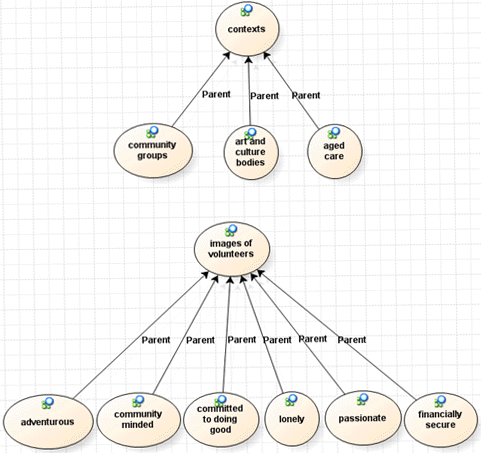
Organized hierarchically, nodes show the shape of the emerging categories, the concepts in which the data are being analyzed.
A well organized hierarchy of tree nodes or cases should:
Allow you to locate a particular node rapidly
Help in recognizing a particular node's relation to other nodes and its place in your project
Provide the ability to see and seek the dimensions of the category represented by a node (Sometimes referred to as "dimensionalizing").
The simple rule is if a node obviously "fits" in your conceptual tree, place it there. If it doesn't, don't force it—create it as a free node until its relation to other nodes becomes clearer.
Node hierarchies are usually best kept coherent and concise. Ensure that conceptually related categories are kept together and unrelated categories apart.
The most common problem hierarchy is one in which a node has been made for every possible combination of categories, rather than coding the same passage at multiple nodes.
If you are unsure whether a category fits into an existing node hierarchy, ask whether it is a sort of the category in question. If it is, it should create a child node within that tree, if it is not, consider whether it should be part of another tree or exist independently (i.e. as a free node). Similarly, if you notice that a node name appears more than twice within your trees, you may need to create it as its own node.
In the Volunteering Sample Project 
A number of contexts in which people volunteer (community groups, foreign countries, art and culture bodies, etc.) are discussed in interviews and focus groups.
Also discussed were the varying images that these participants had of volunteers (adventurous, committed to doing good, lonely, passionate etc.) in these contexts. For instance, were volunteers in community groups perceived differently from those volunteering in foreign countries?
These categories could be represented using tree nodes as follows:

This node hierarchy promises four very serious problems:
It will grow rapidly as more images of volunteers are identified within the sources (all images must appear under each node for a context) or more contexts studied (the new context must appear under each image).
It will impede category development (i.e. it would be difficult to add further dimensions of images, or different types of context).
It will make it difficult to ask more general questions (such as in which contexts are volunteers considered lonely or elderly/retired).
It will also confuse your thinking, since contexts of volunteering are different sorts of things to images of volunteers.
The optimal approach would be to create a tree for volunteering contexts and another tree for images of volunteers and to code text at both the relevant context and the relevant image.

You can then use queries to find content which is coded by particular combinations of nodes.